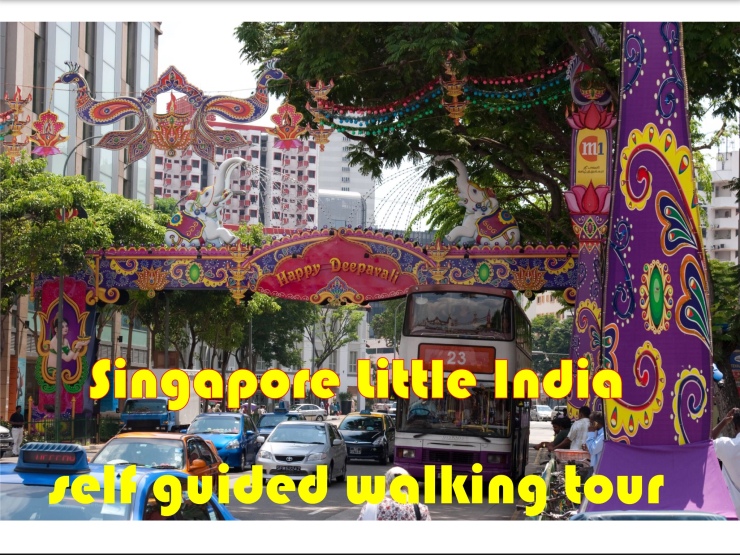 After my last trip to Singapore I realised that it would have made my life easier if I had found a self-guided tour of Little India that allowed me to wander around the area at my leisure. Rather than walking around aimlessly and realising to my regret that I’ve missed some attraction or sight that if I’d know about it before that I would have made a point to visit.
After my last trip to Singapore I realised that it would have made my life easier if I had found a self-guided tour of Little India that allowed me to wander around the area at my leisure. Rather than walking around aimlessly and realising to my regret that I’ve missed some attraction or sight that if I’d know about it before that I would have made a point to visit.
The Lonely Planet guide is a great starting point but unless you have some local knowledge there are always going to be some hidden gems that are off the well-worn tourist trails that you are going to miss. So I’ve tried to include as many of these as well, together with links to the various attraction’s websites so if you feel the need to know more about them the information is at your fingertips.
The starting point of this tour is Exit B from the Farrer Park MRT station. Farrer Park was the site of Singapore’s first racecourse which doubled on non-race days as a golf course, grazing pasture and rifle range. It was also home to a sizeable Indian community; workers and owners of the numerous cattlefarms, rattan processing houses and pineapple factories. You’ll surface, hopefully, on Race Course Road and head north down the street, for a brisk 5min walk.
First stop– Sakya Muni Buddha Gaya Temple – 366 Racecourse Road. The main feature of this Buddhist temple is the central 15-metre tall 300 tonne Buddha statue that draws in worshippers and tourists with both its religious significance and beauty (though beauty is definitely in the eye of the beholder). The statue is surrounded by a stylised aura made of numerous light bulbs, leading to the temple’s popular name, “Temple of a Thousand Lights”. It also houses an ebony and mother-of-pearl replica of Buddha’s footprint found on top of Adam’s Peak in Sri Lanka (which I’ve experienced first hand or should that be foot?). There’s also a statue of the sleeping Buddha in a room below the main temple hall. Entry is free and the temple is open daily between 8:00am and 4:45pm.
Second stop – Leong San See Temple – 371 Racecourse Road – This Taoist temple (known as the “Dragon Mountain Temple” in Mandarin) is one of Singapore’s most ornate Buddhist temples. It was established by Reverend Chun Wu in 1917, who arrived in Singapore in 1913 with only an urn and a statue of Guian Yin, the Goddess of Mercy. The present temple was constructed in 1926 with building materials imported from China. The most remarkable aspect of the building is its roof which contains a sea of dancing ceramic dragons. Inside is an altar to Confucius and behind that an ancestral hall dedicated to the deceased. Opening hours are between 7:30am and 5pm.
Head directly across the street and down the one way street/alleyway, passing the street art on your left and exit under the Chinese arch onto Seragoon Road, turn left and walk about 100m.
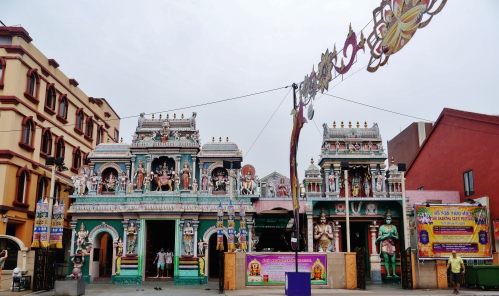
Next stop – Sri Vadapathira Kaliamman Temple – 555 Serangoon Road – dedicated to Kali, Mother of the Universe, this South Indian temple began life in 1870 as a modest shrine but underwent a significant facelift in 1969 to transform it into the beauty standing today. The mandapam, (main hall) holds the shrine to Kali and on either side are two smaller shrines dedicated to the deities Ganesha and Murugan, the sons of Kali. The carvings here, particularly on the Vimana (the stepped pyramid-shape tower) above the garbhagriha (inner sanctum/main shrine), are among the best temple artwork you’ll see anywhere in Singapore.
Do a U-turn (or simply turn around) and head back down Serangoon Road
Next stop– Sri Srinivasa Perumal Temple – 397 Serangoon Road – dedicated to the god, Vishnu – built 1855. The exterior features all those intricately designed Hindu relics which cling to the 20m high Gopuram (the monumental gatehouse tower) and the whole building is just as colourful. However, this temple is dedicated to Krishna, one of the incarnations of Vishnu, and therefore the statues and relics do vary. Inside, there’s more space to move about, making this more of a laidback temple visit, than its slightly more frantic neighbouring temples. Open between 6:30am-12 noon & 6pm-9pm and entry is free.
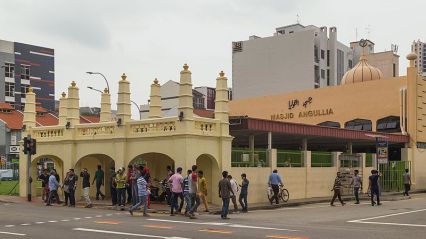
Then just before you reach the Angullia Mosque – 265 Serangoon Road – take a left turn down Syed Alwi Road. The Angullia Mosque was built by the Angullias, Sunni Muslim traders from western India, in 1892. Today, only the entrance gatehouse remains from the original building, as the mosque was recently demolished in to make way for a new four storey mosque, estimated to be completed in late 2019.
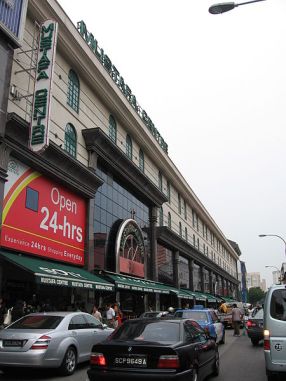
Next Stop – Mustafa Centre – 145 Syed Alwi Road. It’s an enormous, 24 hour-7 day a week, everything-under-one-roof department store, spread over two buildings with six levels, making it one of the most iconic shopping destinations in Little India. Shoppers come from the surrounding neighbourhoods, together with a fair share of tourists wanting a different experience to the fancy shopping malls on Orchard Road. Sure, it’s messy, a little disorganised, and packed every day, but come in search of one specific item that you can’t find anywhere else in town, with over 300,000 items you’ll probably find a whole aisle dedicated to it at Mustafa Centre! It is the perfect place to acquire Asian specialty goods, electronics, food, beauty products, clothing, and just about everything else. The jewelry quarter is where you will find watches and gold for a song—and haggling is welcome.
After surviving the Mustafa experience exit onto Syed Alwi Road and head south until you reach the first cross street, Kamong Kapor Road. Turn right or west on Kamong Kapor Road and continue walking until you get to Hindoo Road (about the fourth street along) head down Hindoo Road and you’ll pass a small pocket park, within which is a intriguing collection of colourful elephants. The end of the street will get you back onto Serangoon Road, take a left/head south along Serangoon Road.
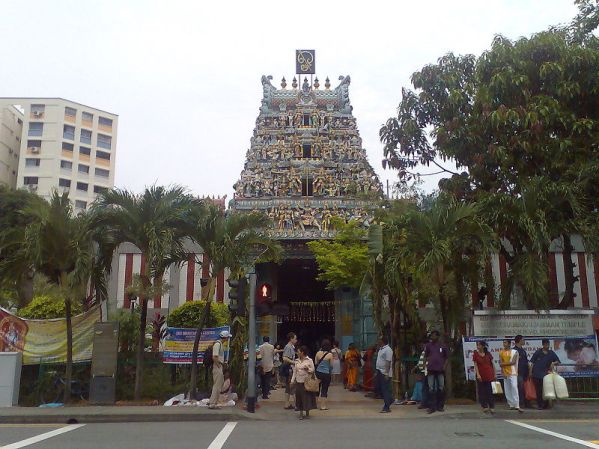
Next Stop – Sri Veeramakaliamman Temple – 141 Serangoon Road (cnr Belilios Road) – yet another temple dedicated to the Hindu goddess and destroyer of evil, Kali. Images of Kali are scattered within the temple show her wearing a garland of skulls and ripping out the intestines of her victims. Built 1881 it is Little India’s most colourful, busiest and most difficult to pronounce temple. Lying at the heart of the neighbourhood on Sarangoon Road, this Hindu temple dates all the way back to the 19th century, although the present structure is much more recent. Sri Veeramakaliamman is hard to miss, with its hundreds of tiny colourful statues blanketing the exterior temple structure. Inside is just as impressive, although expect crowds of worshippers to gather on Tuesdays, Fridays and Sundays. During the Japanese air raids in World War II, many people sought refuge and prayed for safety here and by luck – or divine protection – the temple and all its statues escaped the bombings entirely unscathed. The temple’s opening hours are between 8:00am-12:30pm & 2:00pm-8:30pm daily and entrance is free but don’t forget to dress respectfully and take your shoes/hats off when stepping inside.
At this point cross back over to the other side of Serangoon Road and continue walking south past numerous jewellery, clothing and electronic shopfronts until you get to Campbell Lane, where you turn left.

Parrot fortune tellers – if you’re lucky you find one of these feathered astrologers along Serangoon Road. For just $5, get a glimpse into your future, courtesy of an adorable little critter with clairvoyant powers.
Next Stop – Indian Heritage Centre – 5 Campbell Lane. The galleries within this ultra-modern four-storey museum are chronologically arranged and spans the period from 1st century CE to the 21st century. Here you can learn about the historical links between the Indian sub-continent and Southeast Asia, as well as the experiences of South Asians in Southeast Asia. It’s closed on Mondays and open Tuesdays to Thursdays from 10am to 7pm, Fridays to Saturdays from 10am to 8pm and on Sundays / Public Holidays it’s 10am to 4pm.
Now you have an option you take a detour and turn left onto Clive Street and then take the first right onto Dunlop Street.
Next Stop – Abdul Gafoor Mosque – 41 Dunlop Street – was constructed in 1907 to replace the smaller wooden Dunlop Street Mosque built in 1859. Its unique architecture blends Saracenic and Neoclassical elements such as a beautifully coloured glass cupola reflecting Arabic and Renaissance influence. The mosque is decorated with small minarets, miniature onion-shaped domes and ornate columns, not commonly found in other Singapore mosques. The mosque’s cupola is supported by pillars inspired by Roman architecture and the exterior walls are embellished with crescent moon and star motifs. This 110-year old mosque supplies robes and garments to be worn to ensure that you’re dressed appropriately.
Located just beside the mosque at 43 Dunlop Street is a humble establishment, the Azmi Restaurant. This little hole in the wall serves up possibly the best snack combination of vadai (deep-fried fluffy doughnuts) and teh tarik (pulled tea with milk and sugar). Open from 8am until 8pm.
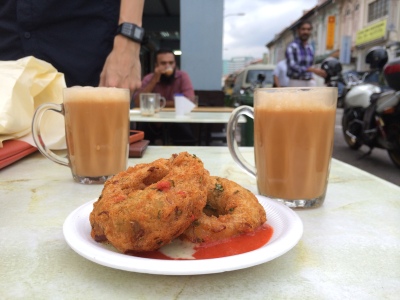
Now walk all the way back down Dunlop Street to Serangoon Road, I told you it was a detour. Head south (again). If you decided to skip the detour you only need to walk back up Campbell Lane to Seragoon Road
Next Stop – Little India Arcade – 48 Serangoon Road, consists of a cluster of conserved neoclassical shophouses built in 1913. This compact series of meandering alleyways provides an amazing collection of individual stores, selling everything Indian: that means traditional dresses, dried herbs and spices, flamboyant accessories, colourful artwork, aromatic incense and traditional sweets. You can also try your hand at bargaining on some of the fresh food (if buying in bulk), or get a discount on some electrical items on sale here too. You could even get yourself a Henna tattoo for under $5 at one of the arcade’s many beauty shops. If your energy levels are low you’ll find it hard to walk past the Moghul Sweet Shop without sampling one of their delicacies, such as a succulent sticky jalebi, or barfi or gulab jamun. The shops in the Little India Arcade are generally open between 9:00am and 10:00pm.
Make your way across to the other side of Serangoon Road and walk down Buffalo Road.
Next Stop – Tekka Centre, located in the northern corner of Bukit Timah Road and Serangoon Road, is a multi-use building complex comprising a wet market, food centre and shops. The market, built in 1915, located across the street, was originally known as “Kandang Kerbau” (Malay for “buffalo pens”), referring to the slaughterhouses operating in the area until the 1920s. In 1982 it was torn down and relocated to its present site, and renamed the Zhujiao Centre, however that was too hard to read and pronounce so in 2000 it was renamed the Tekka Centre. On the ground floor is a hawker centre with stalls which sell Indian vegetarian meals, served on banana leaves or on stainless steel platters. Queue up for biryani, dosa (paper thin, lentil-flour pancake), roti prata (dough-flour pancake) and murtabak (stuffed savoury pancakes). One floor up is a rainbow-coloured sea of Indian sari and textile stores, not to mention a small battalion of tailors. Open every day between 6:30am and 11:00pm, though individual stall hours vary. Given the myriad of choices I’d recommend Yakader Muslim Food (stall #259) for their nasi biriyani or Sri Tiffin (stall #234) for a masala dosa.
There’s a small laneway almost opposite the Tekka Centre, head down the laneway.
Last Stop – The former house of Tan Teng Niah, 37 Kerbau Road – was built in 1900, is possibly Singapore’s most colourful building, the building sits proudly in the centre of Little India. However the former house of Tan Teng Niah isn’t really Indian. As any linguists may have already realised, this building’s roots lie firmly in the Chinese colonialisation of Singapore, and is the only survivor of its type in the neighbourhood. The India community however can take credit for the psychedelic colour scheme for which the house is so famous for.

From here turn left (or west) along Kerbau Road to the first cross street, Race Course Road turn left here and you should find yourself at the Little India MRT station. Before you head downstairs to catch the train make sure you check out the cow mural on the building next to the MRT entrance.
If you haven’t already filled your stomach at the Tekka Centre or overdosed on sugar at the Little India Arcade but still want some authentic Indian cuisine then I suggest that before you jump on the MRT try the Banana Leaf Apolo at 54 Race Course Road (est. 1974). Whilst their signature dish is the legendary fish head curry they also provide a variety of north and south Indian dishes ($10-$15) all served on fresh banana leaves. Open from 10am to 10pm.
If you are interested in exploring more of Singapore – check out my walking tours of Chinatown and Kampong Glam.
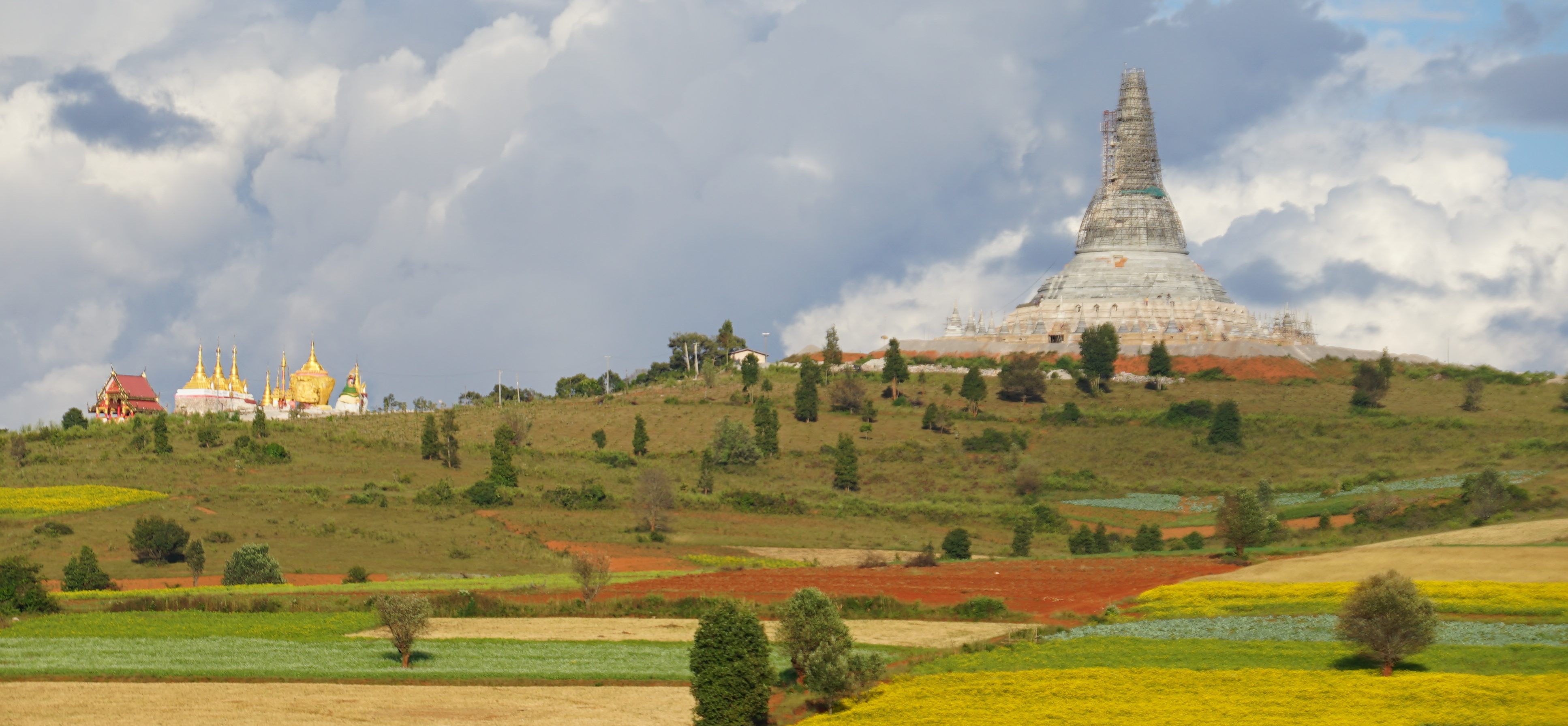



































How long does this walk take
This should only take half a day (leisurely 4-5hours), depending on how long you take to visit the various suggested sites.
Thanks so much for this, it is exactly what I was hoping to find. Have a cruise stop in Singapore and want to make the most of our limited time there. Thank you so much for sharing.
Thank you Elaine, I’d appreciate any feedback you can give me after you’ve tried my walking tour. Have a great holiday. D.
Such a wonderful guide with a mix of different things to see and do…thank you for your time.
Thanks Shane, when we are finally able to freely travel internationally I hope to post some more travel guides